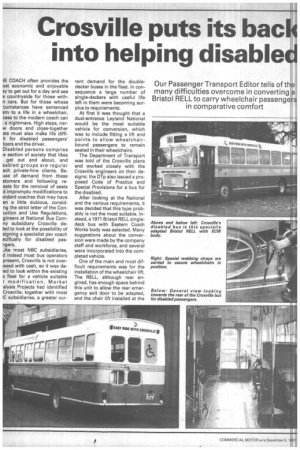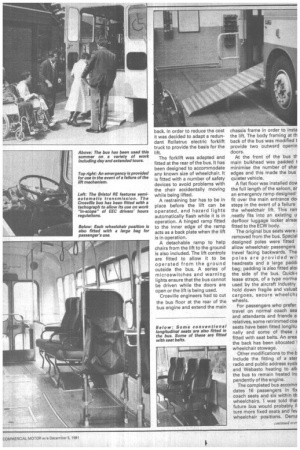Crosville puts its back into helping disabled
Page 30

Page 31

Page 32

If you've noticed an error in this article please click here to report it so we can fix it.
Our Passenger Transport Editor tells of the many difficulties overcome in converting a Bristol RELL to carry wheelchair passengers in comparative comfort
iE COACH often provides the ost economic and enjoyable 5y to get out for a day and see e countryside for those withit cars. But for those whose .cumstances have sentenced ern to a life in a wheelchair, cess to the modern coach can a nightmare. High steps, narw doors and close-together ats must also ma'ke life diffiIt for disabled passengers' ,Ipers and the driver.
Disabled persons comprise le section of society that likes get out and about, and sabled groups are regular ach private-hire clients. Beuse of demand from these stomers and following reests for the removal of seats d impromptu modifications to indard coaches that may have en a little dubious, considng the strict letter of the Conuction and Use Regulations, gineers at National Bus Cornny subsidiary Crosville deled to look at the possibility of signing a specialist psv coach ecifically for disabled pasIgers.
_ike most NBC subsidiaries, d indeed most bus operators present, Crosville is not overmsed with cash, so it was deled to look within the existing s fleet for a vehicle suitable r modification. Market alysis Projects had identified Crosville, together with most IC subsidiaries, a greater cur rent demand for the doubledecker buses in the fleet. In consequence a large number of single-deckers with useful life left in them were becoming surplus to requirements.
At first it was thought that a dual-entrance Leyland National would be the most suitable vehicle for conversion, which was to include fitting a lift and points to allow wheelchairbound passengers to remain seated in their wheelchairs.
The Department of Transport was told of the Crosville plans and worked closely with the Crosville engineers on their designs; the DTp also issued a proposed Code of Practice and Special Provisions for a bus for the disabled.
After looking at the National and the various requirements, it was decided that this type probably is not the most suitable. Instead, a 1971 Bristol RELL singledeck bus with Eastern Coach Works body was selected. Many suggestions about the conversion were made by the company staff and workforce, and several were incorporated into the completed vehicle.
One of the main and most difficult requirements was for the installation of the wheelchair lift. The RELL, although rear engined, has enough space behind this unit to allow the rear emergency exit door to be adapted, and the chair lift installed at the back. In order to reduce the cost it was decided to adapt a redundant Rollatruc electric forklift truck to provide the basis for the lift.
The forklift was adapted and fitted at the rear of the bus. It has been designed to accommodate any known size of wheelchair. It is fitted with a number of safety devices to avoid problems with the chair accidentally moving while being lifted.
A restraining bar has to be in place before the lift can be operated, and hazard lights automatically flash while it is in operation. A hinged ramp fitted to the inner edge of the ramp acts as a back plate when the lift is in operation.
A detachable ramp to help chairs from the lift to the ground is also included. The lift controls are fitted to allow it to be operated from the ground outside the bus. A series of microswitches and warning lights ensure that the bus cannot be driven while the doors are open or the lift is being used.
Crosville engineers had to cut the bus floor at the rear of the bus engine and extend the main
chassis frame in order to insta the lift. The body framing at th back of the bus was modified t provide two outward openin doors.
At the front of the bus th main bulkhead was padded t minimise the number of shar edges and this made the bus quieter vehicle.
A flat floor was installed dov■ the full length of the saloon, ar an emergency ramp designed • fit over the main entrance do' steps in the event of a failure the wheelchair lift. This ran, neatly fits into an existing u derfloor luggage locker alrea( fitted to the ECW body.
The original bus seats were removed from the bus. Special designed poles were fitted allow wheelchair passengers travel facing backwards. The poles are provided wii headrests and a large paddi bag; padding is also fitted aloi the side of the bus. Quick-r lease straps, of a type norma used by the aircraft industry hold down fragile and valuak cargoes, secure wheelchE wheels.
For passengers who prefer travel on normal coach sea and attendants and friends a relatives, some retrimmed coa seats have been fitted longitur nally and some of these E fitted with seat belts. An area the back has been allocated 1 wheelchair stowage.
Other modifications to the b include the fitting of a ster radio and public address systE and Webasto heating to all( the bus to remain heated in( pendently of the engine.
The completed bus accomrr dates 16 passengers in fix coach seats and six within th wheelchairs. I was told thal future bus would probably fi ture more fixed seats and fey wheelchair positions. Dema
far has indicated that most ssengers prefer to travel while qing on the conventional ach seats.
;ince the bus was completed dier this year, it has underta-) a wide variety of private-hire Irk including several eight-day irs to North Wales and Scotd. Other destinations have inded London and Eastbourne. he catchment area for the s extends throughout the isville operating territory in rth-west England and North Iles. Private-hire customers (e included hospitals, area ilth authorities and organise-Is for the disabled.
'he bus is the first specialised licle to be certified by the Detment of Transport as a pubservice vehicle and as such is ilable for anyone to hire. It been fitted with a tachoph to allow any type of work le undertaken.
rosville reckons that the cost conversion is about £8,000. ming costs for the bus are the le as those of any other 11:re vehicle, although the ii secondhand value of the converted bus is probably in the region of £2,500. Although the Bristol is a stage-carriage bus, its ride and performance make it suitable for longer distance operations.
Crosville traffic manager Tony Harrison told me that the bus is operated commercially and its hire rate is similar to that for a conventional coach. On occasions the bus has been hired by individuals wishing to buy some disabled hospital patients a day out, and the vehicle was already being booked for next year. Future bookings included at least one eight-day tour.
The fact that this is the International Year of Disabled Persons has undoubtedly brought the plight of the disabled in relation to public transport and leisure transport to the public mind, although the demand existed before the Year was announced.
Several coach operators up and down the country have coaches fitted with wheelchair lifts, but this is the first National Bus Company vehicle and the first psv certified specifically for the disabled. The engineering ideas in the conversion are in answer to a desire to meet a known demand and this demand exists all over the country.
Several other NBC subsidiaries are already using the Crosville ideas to launch their own specialist buses for disabled persons. Crosville is also in a position to offer conversions to other NBC operators or institutions and private individuals. Many NBC subsidiaries have similar single-deck buses surplus to their requirements and still serviceable. They are anxious not to sell them to potential competitors, but they could provide an ideal vehicle for the use of disabled passengers.
The Bristol RELL used by Crosville is powered by a Gardner 6HLXB engine and features semi-automatic transmission and light steering. From my discussions with Crosville engineers I learned that such a vehicle could be supplied for about the same price as that of a lightweight minibus-type vehicle, and probably for a lot less than the cost of a similarly equipped one.
This International Year makes the launching, and, more importantly, the very operation of this Crosville bus, appropriate. However, it is worth pointing out that this is by no means the only such initiative to help the disabled in the bus world in Britain. While the widespread incorporation of wheelchair lifts in ordinary buses is expensive and impractical — as some experience in the United States has shown — there are many other ways in which bus operators can and are helping.
Among National Bus Company initiatives is the Oxford helper scheme where volunteers aid passengers on and aff buses. Last year an NBC advisory group was set to study ways in which life can be made easier for the disabled. The NBC has followed the lead of South Yorkshire Passenger Transport Executive by adapting Leyland National buses to "kneel" in order to pick up passengers.
Following an experiment in Gillingham, Kent, a route is now to be operated by kneeling Nationals. To make a Leyland National kneel involves one minor suspension modification to allow the air in the front nearside suspension bag to be re leased by the driver to allow the entrance step to be nearer the ground.
,In Leicester the municipal bus , operator, Leicester City Transport, has announced plans to run a special service for the disabled using specially equipped buses.
In conclusion, I would say that Britain's major bus operators are aware of a travel demand from disabled passengers, whether it be for specialised leisure trips, as in the case of the Crosville Bristol RELL, or simply getting from A to B, in the case of the kneeling Nationals. I hope that these innovations will catch on as aids to mobility for the disabled — and not just during this special year.


































































